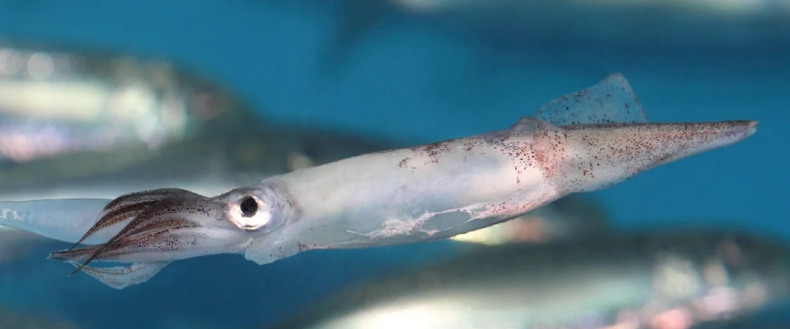
By DANA TIMS/YachatsNews.com
Likely pushed by changing ocean conditions, a new and unusual fishery is emerging off the Oregon coast, already surpassing the value of the salmon harvest and forcing the state to enact new rules and regulations.
Market squid, after turning up in the most significant numbers ever in 2020, drew a record number of boats this year. The nearly $6 million value of the catch doubled that produced by Oregon’s Pacific salmon catch.
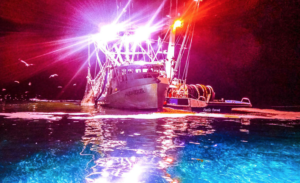
“Squid fishing has not traditionally been a big thing in Oregon,” said Troy Buell, fishery management program leader with the Oregon Department of Fish & Wildlife. “But the numbers we’ve seen the past few years have established this as a significant minor fishery.”
Significant enough, in fact, that the state recently issued its first regulations pertaining to squid fishing. And it’s very likely that an advisory committee now being assembled could recommend further regulations, including one that would restrict the number of permits issued in any single year.
But the big question mark, Buell said, is whether the squid counts that are attracting boats from all along the West Coast will last. Chief among the unknowns about squid is whether they will disappear from Oregon’s coastal waters as rapidly as they started showing up in catchable numbers around 2018.
“Everyone, from boat operators to processors, is asking whether they’ll stick around,” he said. “And the answer is, no one really knows.”
A few squid specifics
Market squid, as this particular species is named, aren’t to be confused with the much larger Humboldt squid, which mainly populate waters off California.
Market squid are among the smallest of the more than 300 species of squid. They are about 12 inches long, travel in densely packed schools and have a life span of just six to nine months.
Typically, about 90 percent of all market squid have been found in California’s Monterey Bay and an area south called the Southern California Bight. Established fleets in those areas are on high alert during the height of the spring spawning season and swoop in as soon as word gets out that squid are around.
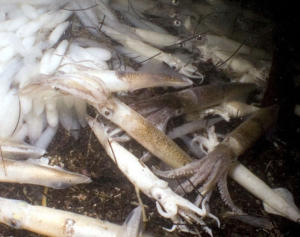
But whether due to El Nino weather affects that result in warming ocean temperatures or other less-known causes, large numbers of market squid recently started showing up off the Oregon coast. Boats that usually patrol California, along with others based in Washington, were among the spiking numbers of boats that roared to areas off Yachats and Newport this spring.
A limited number of Oregon-licensed boats joined in, but their participation illustrates the costly and potentially perilous business decision that owners have to make if they are going to take a vessel outfitted for crab and salmon fishing and retrofit it for squid.
Retrofitting costs can run anywhere from $200,000 to $1 million, Buell said
Traditional crab, shrimp and salmon boats need to be widened substantially to support the large outriggers that lean toward the sea and haul in the nets – or seines – that a separate skiff working as a helper has laid out to encircle a particular school of squid.
Yet another craft, known as a light boat, attracts the squid by shining up to 30,000 watts of light into the water. The light effectively “holds” the squid in place, allowing the skiff operator to set out nets that can scoop up more than 50 tons at a time.
“It’s not an easy conversion,” said Laura Anderson, who comes from a small boat fishing family and owns Local Ocean Dockside Grill + Fish Market in Newport. “It’s no small thing. But once a boat is converted, it pretty much means that the crew are prepared to chase them around whenever a new sighting is reported.”
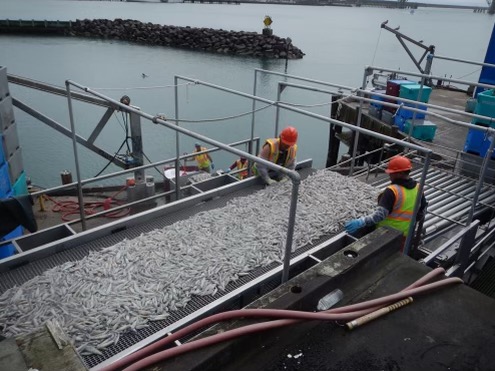
Here’s looking at you, squid
The possibility that squid could high tail it out of Oregon’s waters, leaving operators with steep retrofitting costs and little to show for it, hasn’t stopped new vessels from jumping in. The 18 boats that fished for squid in 2018 spiked to 40 in 2020, according to state records.
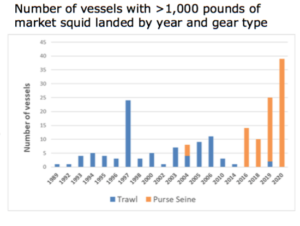
The nearly $6 million squid fishery in the state last year definitely caught the attention of Erik Knoder, the Newport-based regional economist for the Oregon Employment Department. In a recent article, he noted that in 2020, “the market squid harvest shot up 108 percent to $6 million, the highest it’s been since at least 2003. This may herald the establishment of a new important fishery for Oregon since it is now more valuable than the salmon fishery.”
“Even as recently as 2016, the Oregon squid fishery was not a thing,” Knoder said in a follow-up interview. “But it’s definitely on our radar now.”
The fishery is so new, in fact, that only now are a few large processors making inquiries into building processing facilities along the coast. As it is, virtually all market squid landed along the West Coast are frozen and shipped to markets in Asia, where they are thawed and cleaned. The edible tubes and tentacles are then refrozen and, in some cases, shipped back to the U.S. for use mainly as calamari.
“The reimporting aspect might strike some people as highly unusual or even unnecessary,” said Diane Pleschner-Steel, executive director of the California Wetfish Producers Association. “But labor costs here are astronomical compared to Asian countries. “You can catch, export and get it back for less money than U.S. outlets are willing to pay.”
Regulations on the horizon
Now, with the Oregon market growing as fast as it has been, the state is considering new rules aimed at preserving squid populations and addressing environmental concerns affecting areas where squid are found.
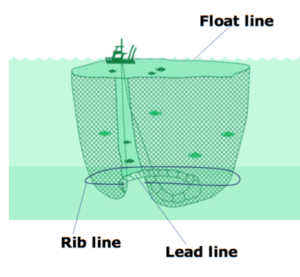
New rules adopted in March, for instance, instituted a weekend closure of all squid fishing to conserve squid, which take up to a full week to spawn. No fishing can take place in established marine reserves or marine protected areas and the seines involved must be configured in a way that they don’t scoop everything along the bottom as they are hauled up.
Looking ahead, the advisory committee now being put together has been asked to consider further regulations, which could include vessel monitoring of squid boats and recommending a date for potential future development of a restricted participation program.
The latter point would, in essence, mean that a limited number of permits would be granted annually, effectively capping the size of Oregon’s squid-fishing fleet.
“We’ll be looking at this very carefully,” the state’s Buell said. “When you select one group of boats that can participate, you are obviously excluding others.”
In a recent informational session available via computer, several Oregon fishermen expressed concern that a limited entry standard could freeze out local boats, while giving a green light to boats from California and Washington.
“It’s one of the key issues that keeps coming up,” Buell said. “But, at some point, we’ve got to ensure that there aren’t more boats than the fishery can sustain.”
- Dana Tims is an Oregon freelance writer who contributes regularly to YachatsNews.com. He can be reached at DanaTims24@gmail.com
Facts about market squid
- Market squid, like clams, mussels and oysters, are members of the mollusk family known as cephalopods, which means ‘foot-on-head’
- Most squid have two hearts; market squid have three.
- Chinese fishermen, hanging torches off their boats to attract squid, established the market squid fishing industry in Monterey Bay in 1863.
- Bright lights used to attract market squid can “hold” them, transfixed, for about three hours.
- Market squid spend most of their short life in deep, offshore waters, coming nearshore to spawn, after which they die.
- Larger squid often prey on market squid.
- Squid have eight arms and two longer tentacles. Like many marine organisms, they have gills to obtain essential oxygen from water.
- Squid lack an external shell, but have remnants of an internal shell. It’s called a “pen” because of its unique shape.
- Market squid have a mixed, iridescent coloration of milky white and purple. They can change their coloring rapidly in response to environmental conditions.
- Most of the market squid landed off the Oregon coast is consumed in Asia.
— Sources: National Oceanic and Atmospheric Administration, California Wetfish Producers Association, Oregon Sea Grant.
To see Troy Buell’s presentation to the ODFW Commission in March, go here.




















